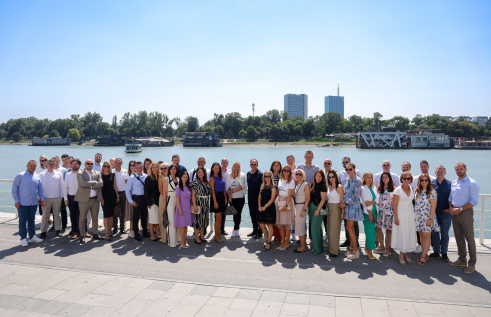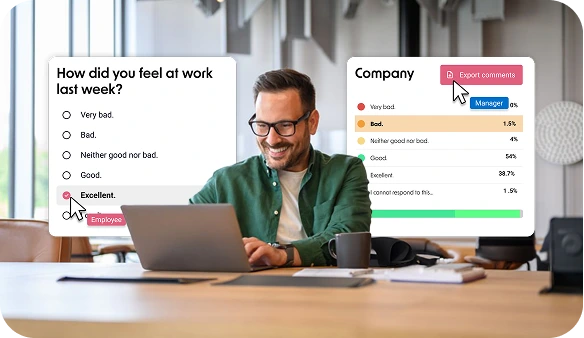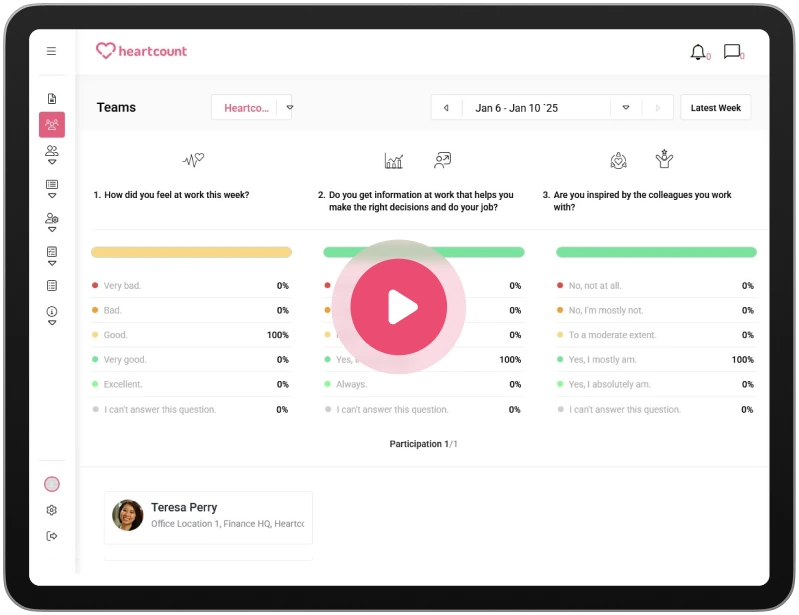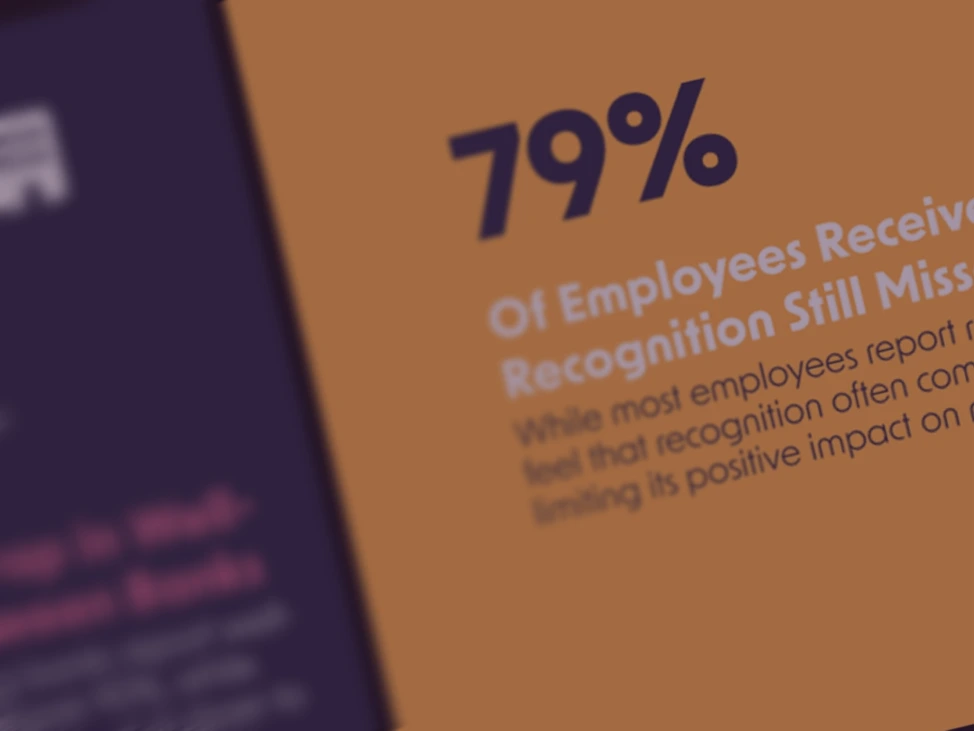How to build a successful HR communication strategy?

People are the heart of any organization, and their engagement, trust, and collaboration are essential for achieving company goals. However, bridging the gap between management and employees requires an effective HR communication strategy.
Without clear communication, organizations can suffer from low engagement and high turnover rates. According to Grammarly’s State of Business Communication report, poor communication can have serious consequences:
- 50% of employees said poor communication has made them feel more stressed
- 34% said it has made them less satisfied with their job
- 30% said it had hurt their confidence at work
- 22% have thought about leaving their job because of bad communication
By nurturing transparency and open dialogue, HR can reduce stress, build trust, and encourage collaboration, creating a more engaged and productive workforce.
People are the heart of any organization, and their engagement, trust, and collaboration are essential for achieving company goals. However, bridging the gap between management and employees requires an effective HR communication strategy.
Without clear communication, organizations can suffer from low engagement and high turnover rates. According to Grammarly’s State of Business Communication report, poor communication can have serious consequences:
- 50% of employees said poor communication has made them feel more stressed
- 34% said it has made them less satisfied with their job
- 30% said it had hurt their confidence at work
- 22% have thought about leaving their job because of bad communication
By nurturing transparency and open dialogue, HR can reduce stress, build trust, and encourage collaboration, creating a more engaged and productive workforce.
What is HR communication?
HR communication is the way a company’s Human Resources department shares information with its employees. It can include anything from company policies and updates to benefits and career development opportunities.
HR communication isn’t just passing along information; it also involves listening to employee feedback and addressing their needs and concerns. Its main goal is to create a clear and open line of communication between management and employees. This helps employees feel connected to the company’s goals, informed about changes, and comfortable sharing their opinions.
For example, regularly updating employees on new policies, offering platforms for feedback, and ensuring that everyone understands their roles are all parts of good HR communication.
Overall, effective communication helps to boost employee engagement, build trust, and ensure that everyone in the company is on the same page about its vision and values. When done right, HR communication contributes to a more satisfied and productive workforce.
Types of HR communication
Effective HR communication takes many forms, depending on the direction in which information flows within an organization. These communication channels help ensure that messages are shared clearly between different levels and departments, improving overall workplace collaboration and satisfaction.
Let’s break down the four main types of HR communication: upward, downward, diagonal, and horizontal.
1. Upward communication
Upward communication happens when information flows from employees to upper management. This is essential for gathering feedback, resolving issues, and ensuring employees feel heard.
A good example of upward communication is an employee satisfaction survey, where workers provide feedback about their experiences. This helps HR understand the employee experience and improve policies or work conditions.
For instance, upward communication might include collecting feedback through pulse surveys or town hall meetings and giving employees a voice in decisions that impact their daily work.
Companies that nurture strong upward communication tend to have higher employee engagement and lower turnover rates, as employees feel their input is valued.
Example of upward communication:
Many organizations, including NLB Bank, have successfully used upward communication strategies to improve employee engagement by implementing feedback loops through surveys and open-door policies.
2. Downward communication
In downward communication, messages are passed from leadership or management to employees. This is often used to communicate company policies, updates, goals, or performance expectations.
Effective downward communication ensures that everyone in the organization receives the same information at the same time, minimizing misunderstandings.
Examples of downward communication:
- HR department sends a company-wide email to announce a new benefits package or an upcoming change in work policy.
- Management announcing a new employee well-being initiative or sharing an updated ESG report
3. Diagonal communication
Diagonal communication occurs between employees of different levels and departments. For instance, an HR manager could discuss a new hiring strategy directly with a junior engineer from another department.
Diagonal communication breaks down traditional hierarchical barriers and allows faster decision-making across departments.
This type of communication can improve collaboration and boost productivity by allowing departments to share knowledge and solve problems more efficiently. In some companies, diagonal communication may also help during times of change or cross-departmental projects, helping create a more collaborative work environment.
Example of diagonal communication:
When a project team comprising HR, marketing, and IT employees needs to coordinate on launching a new employee engagement platform, diagonal communication helps share insights and ideas quickly across departments.
4. Horizontal communication
Horizontal communication happens between employees at the same level within an organization, typically across departments. This form of communication promotes collaboration and ensures smooth workflows by enabling team members to share information and solve problems together.
Horizontal employee communication is especially important for strong employee relations and ensuring smooth coordination on projects such as well-being initiatives or training programs.
Example of horizontal communication:
HR might work closely with the finance department to plan the annual budget for employee training. In this case, both departments work together as equals to achieve a common goal, sharing their expertise to improve the company’s overall productivity and effectiveness.
How to create a successful HR communication strategy
A successful HR communication strategy can improve workplace transparency, productivity, and employee retention.
Follow these steps to implement one:
Step 1: Understand your audience
Before crafting a communication strategy, you must know who your employees are. Different groups may have varying needs and preferences, so segmenting your workforce can make communication more effective.
You might group employees by department, location, or age. This allows you to tailor messages that resonate with each group.
For instance, younger employees may prefer updates via digital platforms or mobile apps, while more senior staff might appreciate detailed emails. Understanding these nuances helps to boost employee engagement, as workers feel that the messages they receive are relevant to their roles.
Step 2: Set clear communication goals
The next step in your HR strategy is to determine what you want to achieve with your communication.
Are you looking to:
- Improve transparency
- Increase employee participation in feedback surveys
- Inform employees about new policies?
Setting clear goals allows you to measure the success of your strategy and make adjustments when necessary.
For example, to reduce employee turnover, you might focus on upward communication, where employees can voice concerns or provide feedback on company policies. Regular surveys and pulse checks can be part of this communication flow to measure employee sentiment over time.
Step 3: Choose the right channels
To effectively reach employees, you can use digital tools, such as internal communication platforms, survey platforms, emails, and even mobile apps.
The key is to choose the channels that best fit your workforce and the type of information being shared.
For example:
- Upward communication: Use anonymous surveys through tools like HeartCount. This platform allows employees to provide feedback and share their opinions openly, which helps management gather insights from the workforce.

- Downward communication: To share information like company policies or updates, send newsletters via email platforms like Mailchimp or internal intranet portals. These tools ensure consistent and clear messages are sent from management to employees.
- Diagonal communication: Use tools like Microsoft Teams or Trello for cross-department collaboration. These platforms facilitate communication and teamwork between employees from different departments and levels.
- Horizontal communication: Collaboration tools like Slack or Asana are ideal for communication between team members on the same level. These tools help coworkers within the same department or across departments share information and coordinate projects efficiently.
Step 4: Develop consistent and clear messaging
Consistency is key when it comes to HR communication. Employees should receive clear, concise, and regular updates.
Whether you’re communicating policy changes, benefits information, or cultural initiatives, keep the messaging consistent to avoid confusion and ensure everyone is on the same page.
Regular updates also create a culture of transparency, which can improve job satisfaction. Employees who feel informed and know what’s happening within the company are more likely to trust leadership.
Step 5: Measure and improve
A successful HR communication strategy is not static; it changes.
Regularly measure the effectiveness of your strategy through employee feedback and performance metrics. You can use surveys, focus groups, or engagement metrics from internal platforms to see how well your communication efforts are working.
By measuring success and areas for improvement, you can make data-driven adjustments to your strategy. This might involve introducing new communication channels, revising messages for clarity, or increasing the frequency of updates.
Benefits of effective HR communication
Effective HR communication is important for building a positive work environment where employees feel engaged, productive, and satisfied.
When HR departments prioritize clear and open communication, it directly impacts several critical areas: employee engagement, productivity, job satisfaction, retention, and the overall employee experience.
Let’s break down these benefits.
1. Increased employee engagement
Clear and transparent communication from HR creates a sense of connection between employees and the company’s mission.
When employees understand the company’s goals and feel that their feedback is valued, engagement levels rise. According to a Gallup study, companies with high employee engagement experience up to 21% greater profitability than those with low engagement.
You can see how effective HR communication affects employee engagement in case of Erste Bank. The company used the HeartCount platform to improve communication and regularly gather employee feedback. The platform allowed them to gather employee input more effectively, leading to important improvements, such as formalizing remote work policies and addressing parking issues.
Over six months, they boosted engagement by rewarding branches with the highest response rates and recognizing employees who actively participated.
HeartCount helped Erste Bank create a more transparent and supportive work environment by responding quickly to employee concerns, ultimately fostering stronger engagement and job satisfaction.
2. Boosted productivity
When communication is clear, employees know what is expected of them, which leads to increased productivity.
A McKinsey study revealed that effective internal communication can increase employee productivity by up to 25% in companies with a high level of connectedness.
Using tools like internal newsletters or collaboration platforms, HR can streamline workflows, reduce confusion, and ensure everyone is on the same page.
For example, cross-departmental projects that utilize horizontal communication allow team members from different areas to coordinate better and deliver faster results.
3. Improved job satisfaction
Effective HR communication ensures that employees feel supported, informed, and valued, which directly influences job satisfaction. According to Grammarly, 56% of workers believe that good communication makes their jobs more satisfying.
Frequent communication about benefits, career growth opportunities, and company culture can also make employees feel more secure and motivated. For instance, regular updates about well-being initiatives and mental health resources can have a huge impact on an employee’s daily work experience.
The case of NLB Komercijalna Banka is a great example of how effective HR communication can transform an organization. After a merger, the bank needed to blend two distinct cultures while maintaining employee satisfaction. By using the HeartCount platform for regular employee feedback through tools like Automated Pulse Check Surveys, the bank created a transparent and open communication strategy that had remarkable results.
Their commitment to clear, consistent communication led to the following:
- A 57% employee participation rate in surveys
- A 4.14 well-being score
- A drop in employee dissatisfaction from 6% to 2.5%
- A 40% response rate to feedback initiatives
This example highlights how effective HR communication, supported by the right tools, can enhance employee satisfaction, reduce turnover, and create a strong, unified culture. The bank also earned a Top Employer Certificate for its commitment to employee well-being and satisfaction.
4. Higher employee retention
Strong communication from HR can reduce employee turnover by creating an environment where people feel they belong.
According to ExecView, companies with open communication channels retain up to 50% more employees than those without such practices.
Employees are more likely to stay when they feel engaged and supported through upward communication, where their feedback and concerns are taken seriously.
Vega IT successfully reduced employee turnover by 7% after implementing the HeartCount platform. As the company grew, traditional job satisfaction surveys failed to provide timely feedback, leading to higher turnover rates and lower morale.
HeartCount allowed them to track employee engagement and satisfaction weekly, providing real-time data that helped management take quick action on employee concerns.
Using PulseCheck Surveys and the Praise Wall, Vega IT improved communication, allowing employees to feel heard and valued. Over the past four years, this shift in their HR communication strategy reduced turnover and contributed to a 30% annual growth in profits, making the company happier and more successful.
5. Enhanced overall employee experience
HR communication also shapes the overall employee experience, from onboarding to exit and stay interviews. Clear communication during every stage of the employee journey helps create a seamless and positive work experience.
According to Pumble, 86% of employees say that a lack of communication from their employer negatively impacts their work performance and general experience.
By providing regular updates, hosting feedback sessions, and ensuring open dialogue, companies can create a culture of trust and transparency, which improves overall employee happiness, satisfaction, and performance.
Strauss Adriatic used HeartCount to enhance the overall employee experience by improving communication and engagement. The company shifted from occasional surveys to weekly pulse checks, allowing real-time feedback and giving employees a consistent voice. Features like peer recognition also fostered a culture of appreciation, where employees felt valued for their contributions.
By addressing employee concerns promptly and improving working conditions, Strauss Adriatic boosted employee satisfaction and created a more positive, engaged workplace. This case demonstrates how continuous feedback and open communication can enhance the employee experience.
How to improve internal communication in the workplace?
Strong internal communication creates a positive and productive environment. When it is clear and open, employees feel more connected, which boosts morale and efficiency.
Here are some practical tips you can implement to improve internal communication:
1. Encourage open feedback loops
One of the simplest ways to improve internal communication is to encourage employees to give feedback regularly.
Companies can implement upward communication strategies, such as anonymous surveys, suggestion boxes, or regular one-on-one meetings, where employees feel safe sharing their thoughts without fear of judgment. Regular feedback helps employees feel heard and gives management valuable insights into the team’s needs and concerns.
Tip: Use tools like employee feedback platforms or pulse surveys to regularly gather insights on what’s working and what’s not in terms of corporate communication.
For example, with HeartCount, you can effortlessly collect your team’s feedback through automatic weekly or biweekly surveys that take just a few seconds to complete.

2. Use multiple communication channels
Different employees prefer different communication styles. Some may respond best to email, while others prefer messaging apps or face-to-face meetings.
Offer a variety of communication channels to ensure that all employees can stay informed in the way that suits them best. For instance, internal messaging platforms like Slack or Microsoft Teams are great for horizontal communication between teams, while company-wide announcements might be better suited to emails or intranet posts.
Tip: Mix digital tools (like instant messaging) with traditional forms of corporate communication (such as in-person meetings) to ensure that everyone receives important messages.
3. Foster transparency and consistency
Transparency in communication builds trust between employees and management.
Regular and clear downward communication from management to employees about major decisions, challenges, or company performance creates a culture of openness, making employees feel more involved. It also prevents rumours from spreading.
Tip: Hold regular company-wide meetings or updates where leadership shares news and answers questions directly from employees.
4. Promote cross-departmental collaboration
Diagonal communication between departments can help break down silos and create a culture of collaboration. It allows employees from different levels and departments to share ideas and problem-solve together. Organizing cross-functional teams or projects is a great way to promote this.
Tip: Organize quarterly brainstorming sessions where employees from different departments can discuss new ideas or address common challenges.
5. Invest in employee training
Not all employees are naturally good at communication; provide training programs to help them improve their skills.
Offer workshops on effective communication, active listening, and emotional intelligence to empower employees to communicate more effectively with colleagues and management.
Tip: Incorporate communication training into onboarding processes and hold refreshers for existing employees. This can also improve employee relations and teamwork.
6. Recognize and celebrate success
Acknowledging employees’ efforts and achievements is another effective way to improve communication and morale. When leaders publicly recognize individual or team accomplishments, it sends a positive message and encourages more open dialogue across the company. This also strengthens corporate communication by reinforcing a culture of appreciation.
Tip: Create a monthly or quarterly recognition program that highlights employees with strong communication and collaboration skills.
Final thoughts
Effective HR communication is the foundation of a thriving workplace. By understanding the different types of communication—upward, downward, diagonal, and horizontal—HR professionals can create strategies that foster engagement, boost productivity, and improve overall job satisfaction.
The benefits of good HR communication go beyond just delivering messages; it helps build trust, retain employees, and enhance their entire work experience.
To truly maximize the benefits of these strategies, you’ll need the right tools.
Heartcount provides critical data and insights that allow HR teams to track engagement, monitor communication effectiveness, and make informed decisions based on real-time feedback. Ready to transform your communication strategy?








